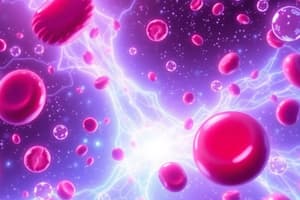Podcast
Questions and Answers
What is the most common complication associated with thrombocytopenia in patients suffering from delayed-onset HIT?
What is the most common complication associated with thrombocytopenia in patients suffering from delayed-onset HIT?
- Deep venous thrombosis (correct)
- Myocardial infarction
- Skin necrosis
- Transient ischemic attack
Which test is specifically designed to measure heparin-dependent platelet activation?
Which test is specifically designed to measure heparin-dependent platelet activation?
- 4T scoring test
- Platelet factor 4 test
- Anti-PF4 ELISA test
- Serotonin Release Assay (correct)
Delayed-onset HIT can lead to unexplained thrombocytopenia how long after heparin therapy has ended?
Delayed-onset HIT can lead to unexplained thrombocytopenia how long after heparin therapy has ended?
- 3 weeks (correct)
- 1 week
- 4 weeks
- 2 weeks
The formation of which complex triggers the production of immunoglobulin G antibodies in hit?
The formation of which complex triggers the production of immunoglobulin G antibodies in hit?
What condition is characterized by an increased likelihood of thrombosis due to platelet activation and aggregation?
What condition is characterized by an increased likelihood of thrombosis due to platelet activation and aggregation?
In the pathophysiology of HIT, the binding of antibodies to what triggers premature thrombocyte clearance?
In the pathophysiology of HIT, the binding of antibodies to what triggers premature thrombocyte clearance?
What is a common, yet severe complication of thrombocytopenia resulting from HIT involving limb arteries?
What is a common, yet severe complication of thrombocytopenia resulting from HIT involving limb arteries?
Which of the following is a limitation of the anti-PF4 ELISA test in the diagnosis of HIT?
Which of the following is a limitation of the anti-PF4 ELISA test in the diagnosis of HIT?
What is the common time frame for the onset of HIT type II symptoms following heparin exposure?
What is the common time frame for the onset of HIT type II symptoms following heparin exposure?
What is the primary action of heparin in the context of thrombosis?
What is the primary action of heparin in the context of thrombosis?
What is the complication associated with heparin that leads to decreased platelet counts?
What is the complication associated with heparin that leads to decreased platelet counts?
Which of the following treatments is NOT used for managing Heparin-induced Thrombocytopenia (HIT)?
Which of the following treatments is NOT used for managing Heparin-induced Thrombocytopenia (HIT)?
What should be monitored in patients receiving heparin to assess the risk of HIT?
What should be monitored in patients receiving heparin to assess the risk of HIT?
What distinguishes HIT type I from HIT type II?
What distinguishes HIT type I from HIT type II?
How does heparin act as a pro-coagulant in cases of HIT?
How does heparin act as a pro-coagulant in cases of HIT?
In patients with prior exposure to heparin, what is the possibility of rapid-onset HIT?
In patients with prior exposure to heparin, what is the possibility of rapid-onset HIT?
At what percentage decrease in platelet count should HIT be suspected?
At what percentage decrease in platelet count should HIT be suspected?
Which statement about the pathophysiology of HIT is correct?
Which statement about the pathophysiology of HIT is correct?
What is the role of antithrombin III in relation to heparin's mechanism of action?
What is the role of antithrombin III in relation to heparin's mechanism of action?
What is the normal platelet count range in x 10^9 per liter?
What is the normal platelet count range in x 10^9 per liter?
What is a possible consequence of heparin acting as a pro-coagulant in patients with thrombotic events?
What is a possible consequence of heparin acting as a pro-coagulant in patients with thrombotic events?
Which diagnostic test is used to confirm the presence of HIT?
Which diagnostic test is used to confirm the presence of HIT?
How does heparin influence platelet function in HIT type I?
How does heparin influence platelet function in HIT type I?
Why is heparin considered an anticoagulant despite its potential to cause HIT?
Why is heparin considered an anticoagulant despite its potential to cause HIT?
Flashcards
Heparin
Heparin
An anticoagulant that inhibits thrombin activity and prevents clotting.
Antithrombin III
Antithrombin III
A protein activated by heparin that inactivates thrombin and factor Xa, preventing clotting.
Fibrinogen
Fibrinogen
A plasma protein converted into fibrin to form blood clots during coagulation.
Fibrin
Fibrin
Signup and view all the flashcards
Heparin Induced Thrombocytopenia (HIT)
Heparin Induced Thrombocytopenia (HIT)
Signup and view all the flashcards
Pro-coagulant
Pro-coagulant
Signup and view all the flashcards
Platelet Count Monitoring
Platelet Count Monitoring
Signup and view all the flashcards
Side Effects of Heparin
Side Effects of Heparin
Signup and view all the flashcards
Normal Platelet Count Range
Normal Platelet Count Range
Signup and view all the flashcards
HIT Type I
HIT Type I
Signup and view all the flashcards
HIT Type II
HIT Type II
Signup and view all the flashcards
Symptoms of HIT
Symptoms of HIT
Signup and view all the flashcards
Diagnosis of HIT
Diagnosis of HIT
Signup and view all the flashcards
Treatment for HIT
Treatment for HIT
Signup and view all the flashcards
Rapid-onset HIT
Rapid-onset HIT
Signup and view all the flashcards
Thrombocytopenia
Thrombocytopenia
Signup and view all the flashcards
Delayed-onset HIT
Delayed-onset HIT
Signup and view all the flashcards
Heparin-PF4 complex
Heparin-PF4 complex
Signup and view all the flashcards
Immune complex (CIC)
Immune complex (CIC)
Signup and view all the flashcards
Hypercoagulable state
Hypercoagulable state
Signup and view all the flashcards
4T Score
4T Score
Signup and view all the flashcards
Anti-PF4 test
Anti-PF4 test
Signup and view all the flashcards
Serotonin Release Assay
Serotonin Release Assay
Signup and view all the flashcards
Study Notes
Heparin-Induced Thrombocytopenia (HIT)
- HIT is a life-threatening complication of heparin exposure
- Patients exposed to heparin, regardless of dose, schedule, or route, are at risk
- Heparin is administered as unfractionated heparin (UFH) or low molecular weight (LMWH) heparin
- HIT is more common with UFH exposure than LMWH due to greater immunogenicity and cross-reactivity with PF4
Types of HIT
-
HIT Type I (Non-immune):
- Mild, temporary drop in platelets in the first 2 days of heparin exposure
- Platelet count returns to normal after heparin is discontinued
- Direct effect of heparin on platelets, not immune-mediated
- Not clinically significant
-
HIT Type II (Immune-mediated):
- Immune-mediated disorder, typically occurring 5-14 days after heparin exposure
- Significant thrombotic complications (life-threatening)
HIT Type II: Onset
- Rapid-onset: Can occur in patients with prior heparin exposure within the last 100 days; platelet count can drop within 24 hours of initiating therapy
- Typical HIT: Onset occurs 5-14 days after heparin therapy begins
- Delayed-onset: Can develop up to 3 weeks after heparin therapy ends; usually presents with thrombosis and thrombocytopenia
HIT: Clinical Manifestations & Complications
- Clinical Manifestations:
- Hypercoagulable state
- Thrombocytopenia
- Complications:
- Deep vein thrombosis (most common)
- Pulmonary embolism (most common)
- Myocardial infarction
- Limb artery occlusion (possible amputation)
- Transient ischemic attack (TIA) or stroke
- Skin necrosis
- End-organ damage (e.g., adrenal, bowel, spleen, gallbladder, or hepatic infarction; renal failure)
- Death
HIT: Diagnosis
- 4T score: A clinical scoring system to assess HIT risk
- Thrombocytopenia (platelet count fall >50% and nadir ≥20 x109/L)
- Timing of platelet count fall
- Thrombosis or other sequelae
- Other causes of thrombocytopenia (none apparent)
- Diagnostic Assays:
- Anti-PF4 test: Immunologic assay detecting IgG antibodies against PF4/heparin complex
- Serotonin Release Assay (SRA): Functional assay measuring heparin-dependent platelet activation (more accurate thrombotic predictor)
Studying That Suits You
Use AI to generate personalized quizzes and flashcards to suit your learning preferences.




